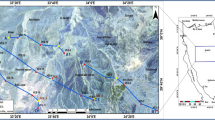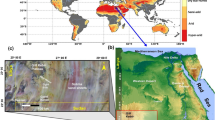Abstract
There is a limited availability of fresh groundwater in the western part of Iraq due to the aridity of the region, and new water supplies are required to meet the demands of potential industrial, mining, and agricultural projects. Consequently, the factors that influence the quality, availability, and distribution of fresh groundwater in the region were assessed by combining hydrogeological, geophysical, and remote-sensing data within a GIS environment. For this purpose, the Shuttle Radar Topography Mission elevation data, geophysical data (gravity and magnetic), and hydrogeological database were used in an integrated approach. It was concluded that both a regionally extensive, deep intergranular aquifer and shallow-fractured and karstified carbonate aquifers have the potential to contain fresh groundwater in the region. It was inferred from the hydrochemical statistics that the main factors controlling groundwater chemistry are the dissolution of evaporite minerals and the weathering of carbonate rocks. Gravity (measured and satellite) data and magnetic data were processed and interpreted to identify the locations and characteristics of subsurface structures. Source Parameter Imaging was applied to calculate depth to the magnetic basement map from gridded magnetic data. The decompensative anomaly maps showed that zones with fresh groundwater are distributed on gravity lows which coincide with areas with a large depth to basement. Most of the fresh groundwater zones in the region are distributed between the pre-Tertiary and Tertiary axes of the Ha’il Arch due to increased recharge along this structure caused by intense fracturing. The extension of the gravity high outside the Iraq territory may suggest similar freshwater zones of groundwater occur in Syria, Jordan, and Saudi Arabia.



(after Sissakian and Fouad 2016)








Similar content being viewed by others
References
Ahmed JB II, Mansor S (2018) Overview of the application of geospatial technology to groundwater potential mapping in Nigeria. Arab J Geosci 11(17):504
Akinluyi FO, Olorunfemi MO, Bayowa OG (2018) Investigation of the influence of lineaments, lineament intersections and geology on groundwater yield in the basement complex terrain of Ondo State, Southwestern Nigeria. Appl Water Sci 8(1):49
Al-Bassam KS, Al-Azzawi AM, Dawood RM, Al-Bedaiwi, JA (2004) Subsurface study of the pre – Cretaceous regional unconformity in the Western Desert of Iraq. Iraqi Geol J 32/33:1–25
Al-Dabbaj AA, Al-Khashab SN (2002a) Hydrogeological and hydrochemical study of Rutbah and Saba`a Ebyar Quadrangles (NI-37-11 & NI-37-10), scale 1:250,000, GEOSURV, int. rep. no. 2798
Al-Dabbaj AA, Al-Khashab SN (2002b) Hydrogeological and hydrochemical study of H1 Quadrangle (NI-37-12), scale 1:250,000, GEOSURV, int. rep. no. 2779
Al-Dabbaj AA, Al-Khashab SN (2002c) Hydrogeological and hydrochemical study of Al-Ramadi Quadrangle (NI-38-9), scale 1:250,000, GEOSURV, int. rep. no. 2776
Al-Furat State Company for Studies and Constructions of Irrigation Projects (2000) Al-Ghadhari project, second stage. Ministry of Irrigation, Baghdad
Al-Jiburi HKS (2002) Hydrogeological and hydrochemical study of Al-Nukhaib area, GEOSURV, int. rep. no. 2774
Al-Jiburi HKS, Al-Basrawi NH (2002a) Hydrogeological and hydrochemical study of Wadi Hauran and H4 Quadrangles (NI-37-15 & NI-37-14), scale 1:250,000, GEOSURV, int. rep. no. 2810
Al-Jiburi HKS, Al-Basrawi NH (2002b) Hydrogeological and hydrochemical study of Wadi Tabbal Quadrangle (NI-37-16), scale 1:250,000, GEOSURV, int. rep. no. 2797
Al-Jiburi HKS, Al-Basrawi NH (2002c) Hydrogeological and hydrochemical study of Mugur Al-Naam and Al-Ubaidat Quadrangles (NH-37-3 & NH-37-4), scale 1:250,000, GEOSURV, int. rep. no. 2740
Al-Jiburi HKS, Al-Basrawi NH (2002d) Hydrogeological and hydrochemical study of Al-Breet Quadrangle (NI-38-1), scale 1:250,000, GEOSURV, int. rep. no. 2737
Anarbaev S, Polkanov M, Araim HI, Sadda SM (1976) Hydrogeological prospecting and exploration in the area of Akashat phosphate deposits, GEOSURV, int. rep. no. 710
Araim HI (1984) Regional hydrogeology of Iraq, GEOSURV, int. rep. no. 1450
Consortium-Water Development Projects, Consortium Yugoslavia (1981) Western Desert, Block 5. Hydrogeological and Hydrochemical Works, Baghdad
Cordell L, Zorin Y, Keller G (1991) The decompensative gravity anomaly and deep structure of the region of the Rio Grande Rift. JGR 96(B4):6557–6568
Dushiyanthan C, Kumar T, Karthikeyan K, Thiruneelakandan B, Davidraju D, Manoharan K (2016) Delineation of shallow aquifer zones using electrical resistivity and bore hole litholog details in the Northwestern part of Bhuvanagiri, Chidambaram Taluk, Cuddalore District, Tamilnadu. J Indian Geophys Union 15(3):71–178
Ejepu JS, Olasehinde P, Okhimamhe AA, Okunlola I (2017) Investigation of hydrogeological structures of Paiko Region, North-Central Nigeria using integrated geophysical and remote sensing techniques. Geosciences 7:122
Farr TG, Rosen PA, Caro E, Crippen R, Duren R, Hensley S, Kobrick M, Paller M, Rodriguez E, Roth L, Seal D, Shaffer S, Shimada J, Umland J, Werner M, Oskin M, Burbank D, Alsdorf D (2007) The shuttle radar topography mission. Rev Geophys 45:RG2004
Fashae OA, Tijani MN, Talabi AO, Adedeji OI (2014) Delineation of groundwater potential zones in the crystalline basement terrain of SW-Nigeria: an integrated GIS and remote sensing approach. Appl Water Sci 4(1):19–38
Fouad SF (2007) Tectonic and structural evolution. In: Geology of the Western Desert. Iraqi Bulletin of Geology and Mining, Special Issue No. 1, pp 29–50
Fouad SFA (2012) Tectonic map of Iraq scales 1:1000,000, 3rd edn. GEOSURV, Baghdad
GEOSURV and GETECH Group plc (2011) Aeromagnetic and gravity data for Iraq; reprocessing, compilation and databasing the aeromagnetic and gravity data of Iraq. rep. no. G1116
Gondwe BRN, Lerer S, Stisen S, Marín L, Rebolledo-Vieyra M, Merediz-Alonso G, Bauer-Gottwein P (2010) Hydrogeology of the south-eastern Yucatan Peninsula: new insights from water level measurements, geochemistry, geophysics and remote sensing. J Hydrol 389(1):1–17
Greenbaum D (1992) Structural influences on the occurrence of groundwater in SE Zimbabwe. Geol Soc Lond Spec Publ 66(1):77–85
Hewaidy AGA, El-Motaal EA, Sultan SA, Ramdan TM, El khafif AA, Soliman SA (2015) Groundwater exploration using resistivity and magnetic data at the northwestern part of the Gulf of Suez, Egypt. Egypt J Petrol 24(3):255–263
Idrotechneco-Consult Progetti (1977) Hydrogeological exploration (block 4), final report, GEOSURV, int. rep. no. 26
Ingra Consulting Department (1964) 100 + 10 wells programme in the Northern and Southern Deserts, GEOSURV, int. rep. no. 318
Iraqi General Institute of Meteorological Information, Iraqi Climate dataset for the years (1970–2005) Baghdad, Iraq
Jassim S, Goff J (2006) Geology of Iraq, Published by Dolin, Prague & Moravian Museum Brno. Printed in (Zech. Repub.), ISBN 80-7028-287-8
Kumar TJR, Balasubramanian A, Kumar RS, Dushiyanthan C, Thiruneelakandan B, Suresh R et al (2016) Assessment of groundwater potential based on aquifer properties of hard rock terrain in the Chittar-Uppodai watershed, Tamil Nadu, India. Appl Water Sci 6(2):179–186
Mousa AS (2017) Using potential methods for tectonic evaluation of Western Desert/Iraq. Ph.D. thesis, Univ. of Baghdad, p 202
Parsons, R.H. Eng. Co. (1955) Groundwater resources of Iraq, vol 8. GEOSURV, int. rep. no. 414
Paterson, Grant & Watson Limited (2004) SPI.GX, version 2.2, Geosof Oaisis Montaj Help Ver.8.4
Ranganai RT, Ebinger CJ (2008) Aeromagnetic and Landsat TM structural interpretation for identifying regional groundwater exploration targets, south-central Zimbabwe Craton. J Appl Geophys 65(2):73–83
Sharland PR, Raymond A, David CM, Roger DB, Stephen HH, Alan HP, Andrew HD, Michael SD (2001) Arabian plate sequence stratigraphy. GeoArabia Special Publication 2, Gulf PetroLink, Manama, Bahrain, p 371
Sissakian VK, Fouad SF (2016) Geological map of Iraq scale 1:1,000,000, 4th edn. GEOSURV Library, Baghdad-Iraq
SOM (1976) Report on hydrogeological and exploration in area of Akashat Phosphate Deposits (1974–1976), GEOSURV, rept No. 710
Thurston JB, Smith RS (1997) Automatic conversion of magnetic data to depth, dip and susceptibility contrast using the SPITM method. Geophysics 62:807–813
UNEP (1992) World Atlas of Desertification. London, UK
Wong JC, Holden E-J, Dentith M, Kovesi P, Fu SC (2006) Geophysics and image analysis group, centre for exploration targeting (CET). The University of Western, Perth
Yadav GS, Singh SK (2007) Integrated resistivity surveys for delineation of fractures for groundwater exploration in hard rock areas. J Appl Geophys 62(3):301–312
Author information
Authors and Affiliations
Corresponding author
Additional information
Publisher's Note
Springer Nature remains neutral with regard to jurisdictional claims in published maps and institutional affiliations.
Rights and permissions
About this article
Cite this article
Jassas, H.A., Al-Bahadily, H.A. & Al-Saady, Y.I. Integrating hydrogeological, geophysical, and remote-sensing data to identify fresh groundwater resources in arid regions: a case study from Western Iraq. Environ Earth Sci 78, 521 (2019). https://doi.org/10.1007/s12665-019-8501-z
Received:
Accepted:
Published:
DOI: https://doi.org/10.1007/s12665-019-8501-z




